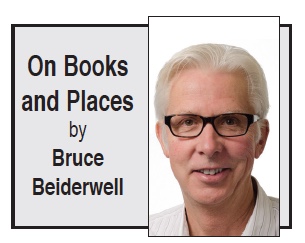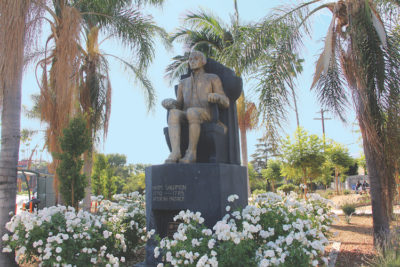On Books and Places: Some statues are worth saving; some people worth remembering

A statue of Haym Salomon resides on the southeast corner of Pan Pacific Park. As I write this column, the bronze figure sits barricaded by a chain link fence and construction activity on Third Street. It’s visible as one drives west towards Farmers Market, but few will now walk near the statue through the surrounding trucks, tools and workmen.
Funny that I had never noticed this statue when the park was fully open to the public and clear of obstructions. My inattention couldn’t last. Monuments of such scale have become objects of charged controversy in the weeks following the murder of George Floyd. The points of discussion aren’t new of course, but never have they been so powerfully foregrounded. What and who do we choose to remember? Why and how do we make those choices? Where do we station monuments? And perhaps most urgently, who is the “we” in these questions?

HAYM SALOMON supported the American Revolution. It was a cause that would break him financially.
Haym Salomon seems a person worth a public remembrance. He brokered, raised, and gave money in support of the 18th-century American revolt against Great Britain. He was imprisoned twice and faced execution as a spy. He escaped to Philadelphia and provided crucial support for Gen. George Washington’s military campaigns. But he didn’t benefit from Washington’s success. Nor could he, a prominent citizen, hold public office in Pennsylvania. Salomon was a Jew. He gave and loaned a substantial fortune for a cause that would break him. He died a poor man at an early age.
Even a quick recounting of such a life invokes worthy themes: on the personal side, service and sacrifice; from the public perspective, gratitude and atonement.
Still, the sheer bronze weight of the monument hasn’t kept it settled in the 74 years since it was cast. As Michael Darling explains in a nice piece on the sculpture published in “LA Taco,” the Salomon memorial has moved about Los Angeles very much in sync with movements among Jewish communities. The monument was first settled in Boyle Heights, then moved near MacArthur Park, then off to the Fairfax district close by its current location.
The permanence signaled by bronze, and the adaptability suggested by the multiple moves, indicate complexities of public memorializing. We’re, after all, honoring not just individuals, but communities and ideals. We’re interested in aspirations as well as past actions.
Communities, ideals, aspirations are abstractions subject to change. What is remembered can be again forgotten. The interests driving remembrances aren’t stable or unassailable. The meaning of the Haym Salomon monument, for example, may be extended to suggest other marginalized or uncredited heroes. Think of Black servicemen who returned from World War II to find Jim Crow laws firmly in place.
Conditions resulting from the pandemic along with the public murder of George Floyd have intensified much dialogue over essential matters as well as accelerated
change — or at least the perception of change. Certainly new forms of memorializing have developed. On my way driving down Third Street to the Farmers Market, I recently saw, just a few blocks before the Haym Salomon monument, a mural painted on an east-facing wall of ModShop. It’s a large portrait of George Floyd by Misteralek (a muralist and commercial artist) that seems to have appeared overnight. The words I first read scrolled under the tragic face were “Change the World.” The
next time I passed and slowed to view more carefully, I noted I had missed seeing a final “d” on the verb: “Changed the World.”
My misreading speaks to our currently unsettled state. “Change” is a command; “changed” is a proclamation. Perhaps both are necessary now. And perhaps such murals
are for the moment exactly the sort of public art that’s needed. Because they are commissioned privately and can be produced quickly and relatively inexpensively, they are able to respond to the moment. They are more ephemeral than bronze, but that can be an advantage, too, for they are easily revisable, replaceable or erasable. They commence a dialogue of what should be rather than pronounce what is. I’ll take the pop-up art that appears on the street over the cynical project proposed by President Trump to memorialize the “greatest Americans” at the very time he is defending existing symbols of white supremacy.
By Bruce Beiderwell
Category: Real Estate
